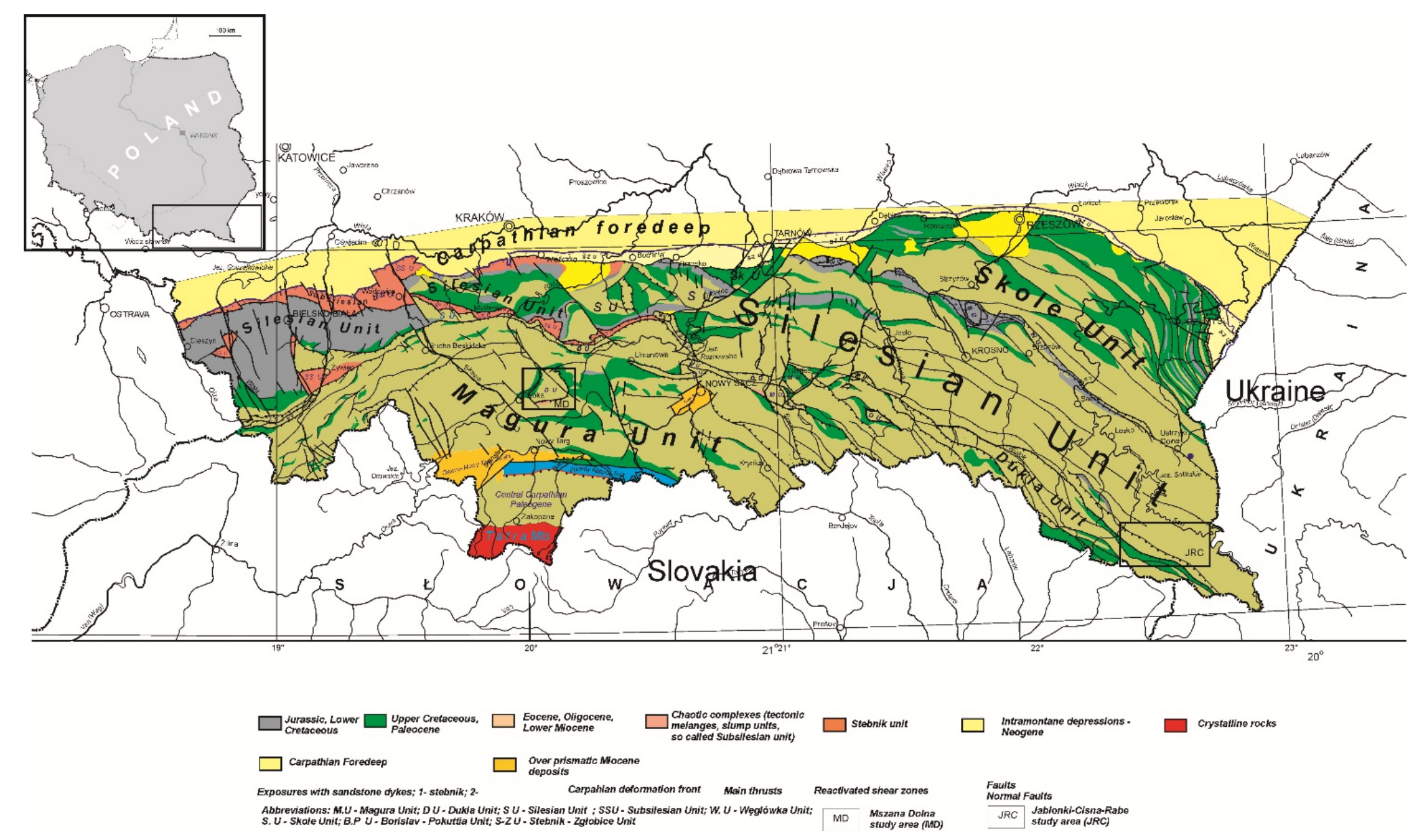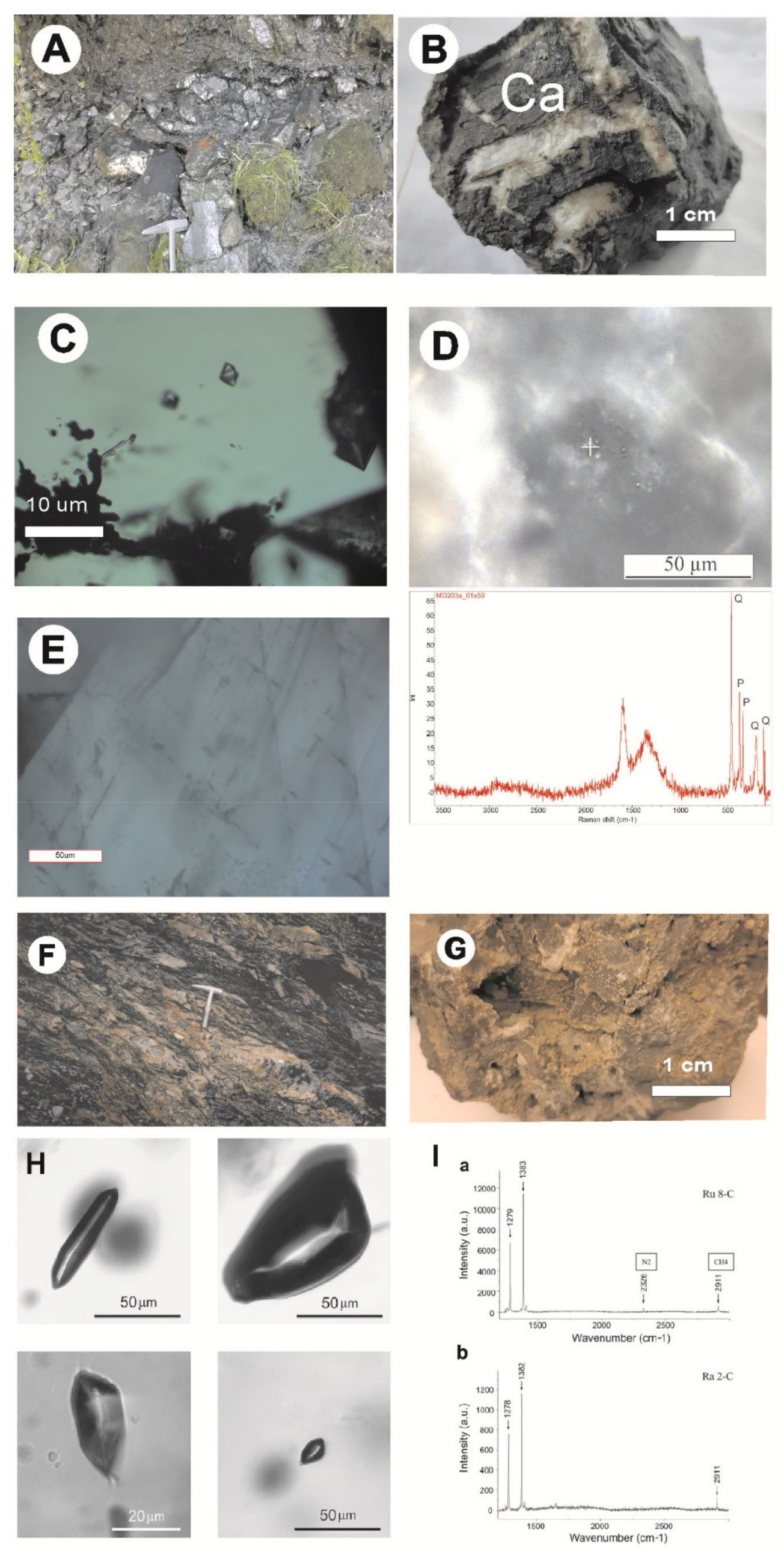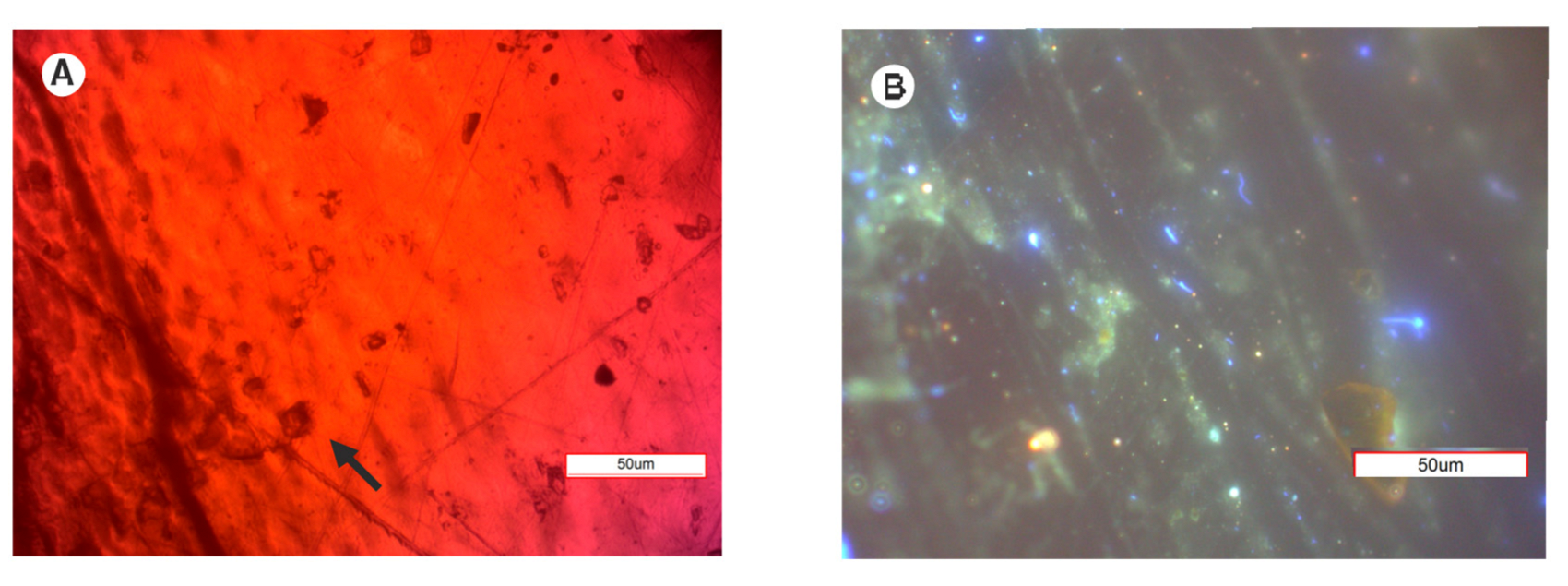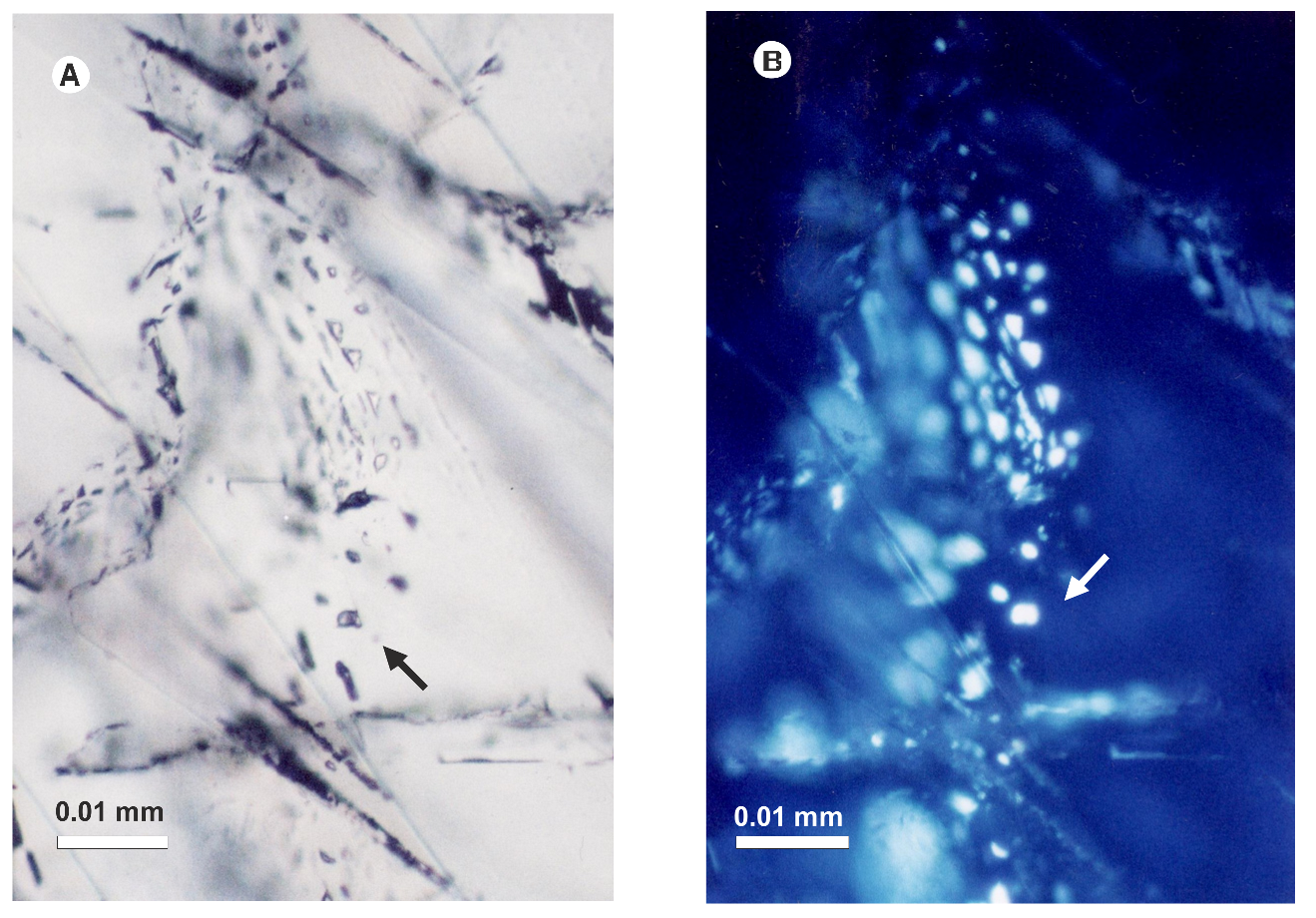Interpretation of Mineralization in the Western Carpathians (Polish Segment)—A Tectonic Mélange Approach
Abstract
:1. Introduction
2. Geological Setting and Mineralogy
3. Materials and Methods
4. Results
5. Discussion
6. Conclusions
- The tectonic mélange zones occur in different localities of the Western Carpathians;
- The mineralization in the mélange zones occurs in veins and accumulations in the rocks of the “block-in-matrix” character;
- The veins are mostly filled with quartz, carbonates and bitumen in different spatial relationship with the presence of other minerals (e.g., realgar, orpiment, pyrite);
- The deep rooting of the mélange zones enables fluid migration from the relatively high depth of the Carpathians, even from their basement;
- The mélange zones represent open geochemical systems which enable both hydrocarbon (in that—also oil seepages) and mineral water migration;
- The mélange zones represent one of the most significant elements of the Carpathian hydrocarbon system;
- Tectonically expelled fluids are responsible both for the mineralization of the rocks and for mineral waters;
- The trapping conditions of fluids (brine and methane) in the minerals in the present studied mélange zones appear to have been of 180–205 °C and ~550–570 bars (in MD) and 220 °C and 500 bars (in JRC) for calcite and quartz, respectively;
- A general trend of increasing temperatures and pressures from W to E and SE may be observed which suggests different degrees of exhumation of the mélange zones;
- The deep-rooted mélange zone in the east (e.g., the JRC region) appears to have been deeper than that in the west (e.g., the MD region);
- The repeating processes of mineralization are connected with the re-opening of the adequate systems as a result of the orogenic collapse events.
Author Contributions
Funding
Acknowledgments
Conflicts of Interest
References
- Jankowski, L. Geological Structure of the Area between Łużna and Stróże; AGH: Krakow, Poland, 1995. (In Polish) [Google Scholar]
- Jankowski, L. A new look at the geological structure of the Carpathians—A discussion. In Prace Naukowe Instytutu Nafty i Gazu—PIB; Instytut Nafty i Gazu, Państwowy Instytut Badawczy: Kraków, Poland, 2015; Volume 202, ISSN 2353-2718. (In Polish) [Google Scholar]
- Jankowski, L.; Jarmołowicz-Szulc, K.; Matyasik, I. Geological and cartographic studies as the basement for mineralogical, geochemical and petrographic analyses. Prz. Geol. 2007, 55, 290. [Google Scholar]
- Jankowski, L. Detailed Geological Map of Poland at Scale1:50,000, Łupków Nowy Sheet; PIG—PIB: Warszawa, Poland, 2015. [Google Scholar]
- Mazzoli, S.; Jankowski, L.; Szaniawski, R.; Zattin, M. Low-T thermochronometric evidence for post-thrusting (<11 Ma) exhumation in the Western Outer Carpathians, Poland. Comptes Rendus Geosci. 2010, 342, 162–169. [Google Scholar]
- Jankowski, L.; Probulski, J. The tectonic and basin development of the Outer Carpathians on the example of the geological structure of the Grabownica, Strachocina and Łodyna fields and the vicinity. Geol. Geophys. Environ. 2011, 37, 555–583. [Google Scholar]
- Dudok, I.V.; Jarmołowicz-Szulc, K. Vein minerals in Polish and Ukrainian Carpathians. Prz. Geol. 2001, 48, 341–342. [Google Scholar]
- Jarmołowicz-Szulc, K. Characteristic features of the vein formation in SE part of the Polish Carpathians. Geol. Carpathica 2002, 53, 4. [Google Scholar]
- Jarmołowicz-Szulc, K. Studies on quartz as the tracer of fluid migration. In Proceedings of the International Congress of Applied Mineralogy—ICAM 2004, ICAM, Aguas de Lindoia, Brazil, 19–22 September 2004. [Google Scholar]
- Jarmołowicz-Szulc, K.; Dudok, I.V. Migration of palaeofluids in the contact zone between the Dukla and Silesian units, Western Carpathians—Evidence from fluid inclusions and stable isotopes in quartz and calcite. Geol. Quart. 2005, 49, 291–304. [Google Scholar]
- Jarmołowicz-Szulc, K. A mineralogical and geochemical contribution to the studies on problematics of fluid flows in the Carpathians. Min. Rev. 2009, 59, 42–55. [Google Scholar]
- Jankowski, L.; Jarmołowicz-Szulc, K. Particular tectonic zones (the mélange zones) as a potential and significant path for fluid migration and mineral formation. Min. Rev. 2009, 59, 31–44. [Google Scholar]
- Jarmołowicz-Szulc, K.; Jankowski, L. Geochemical analysis and genetic correlations for bitumen and rocks of the black shale types in the outer Carpathian tectonic units in southeastern Poland and the adjacent territory. Biul. Państw. Inst. Geol. 2011, 444, 73–98. [Google Scholar]
- Jarmołowicz-Szulc, K.; Karwowski, Ł.; Marynowski, L. Fluid circulation and formation of minerals and bitumen in the sedimentary rocks of the Outer Carpathians—Based on studies on the quartz –calcite- organic matter association. Mar. Petr. Geol. J. 2012, 32, 138–158. [Google Scholar] [CrossRef]
- Jarmołowicz-Szulc, K. Fluids expelled tectonically and their significance in hydrocarbon migration. Int. J. Pet. Petrochem. Eng. 2017, 3, 1–6. [Google Scholar] [CrossRef]
- Karwowski, Ł.; Dorda, J. Mineral—Forming environment of “the Marmarosh diamonds”. Mineral. Pol. 1986, 17, 3–12. [Google Scholar]
- Nemčok, M.; Pospíšil, L.; Lexa, J.; Donelick, R.A. Tertiary subduction and slab breakoff model of the Carpathian–Pannonian region. Tectonophysics 1998, 295, 307–340. [Google Scholar] [CrossRef]
- Sperner, B.; Ratschbacher, L.; Nemčok, M. Interplay between subduction retreat and lateral extrusion: Tectonics of the Western Carpathians. Tectonics 2002, 21, 1051. [Google Scholar] [CrossRef] [Green Version]
- Nemčok, M.; Pospìšil, L.; Hrušecky, I.; Zsìros, T. Subduction in the remnant Carpathian flysch basin. AAPG Mem. 2006, 767–778. [Google Scholar] [CrossRef]
- Jankowski, L.; Kopciowski, R.; Ryłko, W. Geological Map of the Outer Carpathians: Borderlands of Poland, Ukraine and Slovakia, 1:200.000; Polish Geological Institute: Warszawa, Poland, 2007. [Google Scholar]
- Jankowski, L. Chaotic complexes in the Gorlice region (Polish Outer Carpathians ). Biul. Państwowego Inst. Geol. 2004, 426, 27–52. [Google Scholar]
- Jankowski, L.; Margielewski, W. Geological control of the Outer Western Carpathians’ relief formation: From basinal stage to gravitational collapse—A new approach. In Proceedings of the Book and Abstracts of 4th Central European Geomorphology Conference, Bayeruth, Germany, 9–13 October 2017; Holzheu, S., Thies, B., Eds.; University of Bayeruth: Bayeruth, Germany; Volume 120, pp. 21–22. [Google Scholar]
- Andreucci, B.; Castelluccio, A.; Jankowski, L.; Mazzoli, S.; Szaniawski, R.; Zattin, M. Burial and exhumation history of the Polish Outer Carpathians: Discriminating the role of thrusting and post-thrusting extension. Tectonophysics 2013, 608, 866–883. [Google Scholar] [CrossRef]
- Jarmołowicz-Szulc, K.; Jankowski, L.; Matyasik, I. Preliminary results of the studies of mineral assemblages and the organic matter in the Bieszczady region. Prz. Geol. 2007, 55, 291. [Google Scholar]
- Jarmołowicz-Szulc, K.; Toboła, T. Microthermometric and Raman spectra studies in minerals in the Rabe vicinity (Carpathians)—An experimental practice. Prz. Geol. 2021, 69, 361–364. [Google Scholar]
- Joachimski, M.; (Friedrich-Alexander University Erlangen-Nürnberg, Erlangen, Germany). Personal Communication, 2020.
- Roedder, E. Reviews in Mineralogy, Fluid Inclusions. Miner. Soc. Am. 1984, 12, 1–254. [Google Scholar]
- Goldstein, R.H.; Anderson, A.; Marshall, D. Petrographic analysis of fluid inclusions. Fluid Incl. Anal. Interpret. 2003, 32, 9–54. [Google Scholar]
- Goldstein, R.H.; Reynolds, T.J. Systematics of fluid inclusions in diagenetic minerals. SEPM Short Course 1994, 31, 199. [Google Scholar]
- Brown, P.E. FLINCOR: A microcomputer program for the reduction and investigation of fluid inclusion data. Am. Min. 1989, 74, 1390–1393. [Google Scholar]
- Bodnar, R.J.; Samson, I.; Anderson, A.; Marshall, D. Interpretation of data from aqueous-electrolyte fluid inclusions. Fluid Incl. 2003, 32, 81–101. [Google Scholar]
- Jankowski, L.; Jarmołowicz-Szulc, K. The preliminary mineralogical characteristic of the tectonic mélange in the Bieszczady Mts. In Proceedings of the Search on Hydrocarbons as the Source of Innovation in Recognition of Geological Structure of the Carpathians, the Carpathian Foredeep and Their Basement. LXXV Scientific Conference PTG, Iwonicz-Zdrój, Poland, 22–25 September 2004; Conference Materials, 122. Państwowy Instytut Geologiczny: Cracow, Poland, 2004. (In Polish). [Google Scholar]
- Wieser, T.; (PGI: Cracow, Poland). Sampling in the Rabe Region and Personal Communication, 2001.
- O’Neil, J.R. Stable isotope geochemistry of rocks and minerals. In Lectures in Isotope Geology; Jaeger, E., Hunziker, J.C., Eds.; Springer: Berlin, Germany, 1979; pp. 235–263. [Google Scholar]
- Dudok, I.V.; Kotarba, M.; Jarmołowicz-Szulc, K. Employment of pyrolitic methods in geochemical studies of organic matter of the vein formations in the flysch of the Carpathians Mts. Geol. Geochim. Goriuchih Kopalin 2002, 1, 76–87. (In Ukrainian) [Google Scholar]
- Kouketsu, Y.; Mizukami, T.; Mori, H.; Endo, S.; Aoya, M.; Hara, H.; Nakamura, D.; Wallis, S. A new approach to develop the Raman carbonaceous material geothermometer for low-grade metamorphism using peak width. Island Arc. 2014, 23, 33–50. [Google Scholar] [CrossRef]
- Matyasik, I.; (Institute for Oil and Gas: Cracow, Poland). Personal Communication, 2010.
- Friedman, I.; O’Neil, J. Compilation of stable isotope fractionation factors of geochemical interest. In Data of Geochemistry; Fleischer, M., Ed.; U.S. Geological Survey: Liston, VA, USA, 1977; Volume 440-K, pp. 1–12. [Google Scholar]
- Kozłowski, A.; Metz, P.; Młynarczyk, M. Crystallization conditions of Marmarosh diamonds from the Carpathian flysch, as indicated by fluid inclusion studies. In Proceedings of the Jahrestagung der Deutschen Mineralogischen Gesellschaft, Kiel, Germany, 9–12 September 1996. Berichte der Deutschen Mineralogischen Gesellschaft—Nachtrag von Kurzreferaten. [Google Scholar]
- Świerczewska, A.; Hurai, V.; Tokarski, A.K.; Kopciowski, R. Quartz mineralization in the Magura nappe (Poland): A combined microstructural and microthermometry approach. Geol. Carpath 1999, 50, 174–177. [Google Scholar]
- Hurai, V.; Kihle, J.; Kotulova, J.; Marko, F.; Świerczewska, A. Origin of methane in quartz from the Tertiary accretional wedge and forearc basin of the Western Carpathians. Appl. Geochem. 2002, 17, 1259–1271. [Google Scholar] [CrossRef]
- Zuber, A.; Chowaniec, J. Diagenetic and other highly mineralized waters in the Polish Carpathians. Appl. Geochem. 2009, 24, 1899–1900. [Google Scholar] [CrossRef]
- Hajto, M. Characteristics of main hydrothermal structures prospective for binary technologies. In Atlas of the Possible Use of Geothermal Wares for Combined Production of Electricity and Heat Using Binary Systems in Poland; Bujakowski, W., Tomaszewska, B.E., Eds.; IGSMiE PAN: Cracow, Poland, 2014; pp. 25–74. ISBN 978-836-2922-33-8. (In Polish) [Google Scholar]








| Sample | Ba | Cr | Cu | La | Mn | Mo | Ni | Sr | Ti | V | Zr |
|---|---|---|---|---|---|---|---|---|---|---|---|
| U1 | <5 | 14 | <5 | <5 | 1207 | <2 | 4 | 589 | 84 | <5 | 9 |
| PD4 | 99 | 16 | <5 | <5 | 1163 | <2 | 5 | 1304 | 93 | <5 | 11 |
| D9 | <5 | 15 | <5 | <5 | 1066 | <2 | 5 | 694 | 88 | <5 | 5 |
| PD21 | <5 | 3 | <5 | <5 | 704 | <2 | <3 | 865 | 75 | <5 | 6 |
| W13 | <5 | 11 | <5 | <5 | 1102 | <2 | 5 | 916 | 80 | <5 | 6 |
| PS1 | 487 | 9 | <5 | <5 | 1078 | <2 | 3 | 631 | 143 | 5 | 7 |
| PS2 | <5 | 8 | <5 | 6 | 1007 | <2 | 5 | 773 | 115 | <5 | 6 |
| Sample 1 | Locality | Mineral/FI Type | Ice Melting Temperature Tm (°C) | Homogenization Temperature Th (°C) 2 | Homogeni Zation Temperature Th (°C) 3 | Homogeni Zation Temperature Th (°C) 4 | Salinity NaCl (wt % eq.) |
|---|---|---|---|---|---|---|---|
| UG-16/08-6 | Ustrzyki Górne | Quartz/ AQFI HCFI | −0.1 | −95.1 | +14.3 | +117.3 +125.0 +145.3 +146.0 +132.0 | 0.166 |
| MD2/08-1 | Mszana Dolna | Quartz/ HCFI | −82.2 −77.8 −103 −87.5 | −57.6 −60.0 −56.6 | +8.5 +16.8 +13.2 +16.0 | ||
| MD 2A/08 | Mszana Dolna | Quartz/ HCFI | −103 −87.5 | ||||
| Ru 4/09 | Jabłonki | Quartz/ HCFI | −0.6 | −61.2 | +128.7 | 0.172 | |
| Ru 8/07 | Jabłonki | Quartz/ AQFI HCFI | −1.3 −2.1 | −90.7 | −77.4 | +183.9 +19.2 +22.1 | 2.14 3.49 |
| Ka-13 | Kalnica | Calcite/ AQFI | −5.6 | −77.4 | +199.9 | 8.6 | |
| Ra-1/07-1 | Rabe | Quartz/ AQFI HCFI | −1.1 −1.8 | −88.8 −88.8 | +175.9 | 1.80 2.96 | |
| Ja 7/03 * | Jabłonki | Quartz/ AQFI HCFI | −1.1 | −91.4 | +173.0 | 1.80 | |
| Ja-10 * | Jabłonki | Quartz/ AQFI HCFI | −1.3 | −80 −75 | −58.0 −56.7 | n.d. | |
| B-2002 * | Jabłonki | Quartz/ AQFI HCFI | n.d. | −92.0 −90.0 | +150.0 +172 | ||
| B-8 * | Jabłonki | Quartz/ HCFI | −77.0 −76.6 | Decr.+85 +95 | |||
| Wo-12/07 | Wołosa-te | Quartz/ HCFI | −88.6 −84.9 | ||||
| We 20 | Wetlina | Quartz/ HCFI | +79.7 +77.9 |
| Sample ID | Locality | Position ** | δ13C ‰ (PDB) | δ18O ‰ (PDB) | δ18O * ‰ (SMOW) |
| Area: JRC *** | |||||
| Ka 15/07 | Kalnica, PL | −0.05 | −8.31 | +22.29 | |
| Cisna 3/06 | Cisna, PL | −0.11 | −7.51 | +23.12 | |
| Cisna 10/07 | Cisna, PL | 49°13.383″ 22°21.217″ | −0.19 | −6.67 | +23.98 |
| Kalnica 13 | Kalnica, PL | −1.02 | −8.42 | +22.18 | |
| Ru 9/07 | Jabłonki, PL | −2.89 | −9.73 | +20.83 | |
| Sample ID | Locality | Position ** | δ13C ‰ (VPDB) ±0.06 | δ18O ‰ (VPDB) ±0.03 | δ18O * ‰ (SMOW) |
| Area: MD | |||||
| Szcz4/2020 | Szczawa | −0.07 | −7.99 | +22.62 | |
| MD 22/08 | Mszana Dolna region | −0.90 | −8.97 | +21.61 | |
| MD 2/08 | Mszana Dolna region | −4.53 | −9.44 | +21.13 | |
| MD 201/2020 | Mszana Dolna | 49°35.9699′ N 20°03.87549′ E | −5.38 | −10.85 | +19.68 |
| MD 203A/2020 | Mszana Dolna | 49°40.4229′ N 20°07.2976′ E | −6.05 | −11.41 | +19.06 |
| Characteristics | Beskidy Zachodnie * | Bieszczady * | Eastern and South-Eastern Directions | References |
|---|---|---|---|---|
| Temperature (°C) | 75–137 → | 116–196 → | 110–230 | [7,10,25,39,40] |
| Pressure (kbar) | 0.49–1.3 Mszana Dln about 0.99 MPa → | 0.56–2.2 Rabe-Wołosate 0.8–1.5 → | 0.5–2.7 Stavne-Volovec (Ukraine) 1.4–2.7 Dara (Slovakia) 1.65–2.06 | [41] |
| Brine salinity (weight % NaCl eq.) | 1.5–11.5 | 4–14 3–4 |
Publisher’s Note: MDPI stays neutral with regard to jurisdictional claims in published maps and institutional affiliations. |
© 2021 by the authors. Licensee MDPI, Basel, Switzerland. This article is an open access article distributed under the terms and conditions of the Creative Commons Attribution (CC BY) license (https://creativecommons.org/licenses/by/4.0/).
Share and Cite
Jarmołowicz-Szulc, K.; Jankowski, L. Interpretation of Mineralization in the Western Carpathians (Polish Segment)—A Tectonic Mélange Approach. Minerals 2021, 11, 1171. https://doi.org/10.3390/min11111171
Jarmołowicz-Szulc K, Jankowski L. Interpretation of Mineralization in the Western Carpathians (Polish Segment)—A Tectonic Mélange Approach. Minerals. 2021; 11(11):1171. https://doi.org/10.3390/min11111171
Chicago/Turabian StyleJarmołowicz-Szulc, Katarzyna, and Leszek Jankowski. 2021. "Interpretation of Mineralization in the Western Carpathians (Polish Segment)—A Tectonic Mélange Approach" Minerals 11, no. 11: 1171. https://doi.org/10.3390/min11111171
APA StyleJarmołowicz-Szulc, K., & Jankowski, L. (2021). Interpretation of Mineralization in the Western Carpathians (Polish Segment)—A Tectonic Mélange Approach. Minerals, 11(11), 1171. https://doi.org/10.3390/min11111171






